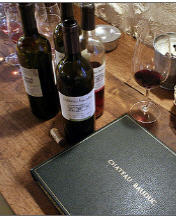 Like a fine wine, the idea of actually hosting a fundraiser needed to age for a bit. Initially, I had visions of hosting a gala event, replete with a full bar, servers, a band, table linens, and a little black dress.
Like a fine wine, the idea of actually hosting a fundraiser needed to age for a bit. Initially, I had visions of hosting a gala event, replete with a full bar, servers, a band, table linens, and a little black dress.
But a few weeks into the aging process, after making a few calls, asking for prices, and trying to find donations for the silent auction that would be the backdrop for my fun-filled evening with a purpose, (not to mention trying to find the perfect black dress), my grandiose vision became an all-consuming logistical marathon. When coupled with finding the time to log 35 or more weekly training miles, it was more than I could take on.
The Challenge
Faced with the challenge of running my first full marathon and raising $2,800 for the Leukemia & Lymphoma Society in 100 days, I had several strategy sessions (over wine) with some friends who were more than willing to pitch-in however they were needed. I talked (more like “I panicked”), they listened, and gradually my grand gala idea morphed into more of an intimate gathering of friends. Maybe it was the wine talking, but I think the importance of the intimate gathering of friends, helping to support me as I supported the cause, revealed itself as the key value.
The Idea
Initially, I was reluctant to ask people for funds, especially my close friends and family. But, when I explained my purpose, I realized that people were quite supportive of my efforts. So I decided to turn the tables a bit. Instead of asking people for donations or a cover charge to attend my event, I sent out invitations explaining what it was that I was doing (running a full marathon in honor of a friend diagnosed with lymphoma). I also explained that I was grateful for the support (key word, support) of friends and family (and ”the friends and/or family of friends”) in whatever form that support came – prayers, thoughts of positive energy while I was running, monetary donations, running partners, packs of GU, boxes of blister band-aids, email encouragement, etc. Thus the event, an informal wine tasting, became more of a “thank you” for that support.
The Process
Because I had already made a number of calls and visits to local establishments regarding the initial grand gala plan, I revisited a select few that had already indicated an interest in participating in some way. My local wine shop donated the wine for the event (and gave out coupons for case discounts to the attendees). In addition, they also provided me with a full slate of tasting notes for each of the 6 wines. I also received discounts on the food (cheese, crackers, light hors d’œuvres from a grocery store). I found that many stores are happy to discount or donate supplies for fundraising parties in lieu of making monetary donations.
The Format
The format of the evening was casual and fun. I hosted it at my house, but a clubhouse or small restaurant banquet room would be great, too. Since the wine store provided 3 bottles of each of the 6 kinds of wine (three white and three red), I set the bottles up on a long table, with the tasting notes for each in front of the bottle. I greeted each person as they arrived and handed them a glass. The cheesy bits, crackers, bread, and other light snacks were on a separate table. My general instructions were, “Start from left to right (whites, then reds)” – simple, straight forward, and easy. Each person could read the notes and taste at their leisure since it was more of an informal gathering. There was no pressure to taste each wine and everyone was free to revisit the wines they enjoyed most. Plus, everyone enjoyed mingling with the other guests to talk about their favorite wines.
The Results
 About mid-way through (at least 6 or 7 bottles into the evening), I thanked everyone again for all of their support and encouragement throughout my journey thus far and the checkbooks opened. I ended up with a total in excess of $1500 for that one evening (not including the wine and food donations). I even received donations from people who weren’t able to make it to the wine-tasting, but were kind enough to give those who did a check or cash to give to me!!
About mid-way through (at least 6 or 7 bottles into the evening), I thanked everyone again for all of their support and encouragement throughout my journey thus far and the checkbooks opened. I ended up with a total in excess of $1500 for that one evening (not including the wine and food donations). I even received donations from people who weren’t able to make it to the wine-tasting, but were kind enough to give those who did a check or cash to give to me!!
I think the point is that although sometimes we are hesitant to ask people for donations, we should never hesitate to thank people for their support and encouragement. Although I was concerned about meeting my fundraising goal for the marathon and relied heavily on the donations of others to meet that goal, the more important aspect of networking and asking for support was to get just that … support. It comes in all shapes and forms: encouragement, kind words, blog comments, prayers, running partners, and monetary donations. Don’t discount the value in building a network of support – donations of time in the form of a race partner or a shoulder to cry on after your first 20 mile run, are extremely valuable. And the larger your network, the more resources you will find (or will find you) to provide the support you need both financially and mentally. Just be willing to share information about your cause and why it’s important to you.
The Tips
My personal goal for the marathon was $2800 but I raised $5000 in less than 4 months mainly through networking and sharing information. The following are my tips to a successful, focused campaign.
- Consider planning a small (20 – 30 people) main event but plan to invite 40 – 60.
- Ask local or neighborhood wine shops/liquor stores to donate or provide wine at cost.
- Ask local or neighborhood restaurants to host the event and/or to donate or discount the food.
- Publish your invitation as more of a “thank you for your support” as opposed to “please give money”.
- Following your event, send thank yous to your entire guest list (those who attended and those who didn’t) as well as the vendors who participated.
- Email regular updates of your training and fund raising progress to the guest and vendor lists. When people are informed, they feel involved. To any that were unable to make it to your event, they may still be willing to donate because you keep them up-to-date with your progress. (That’s where the invite 40 – 60 people comes in to play.)
- Create a blog to track your progress and include the URL in your email signature. People can drop in to see how you’re doing between your updates. Also, it’s extremely easy for people to forward an email on to someone else and you want those people to have access to see your blog as well.
- Be considerate of filling people’s in-boxes by providing “an opt out/unsubscribe” option. This will help narrow down your potential donors.
Like a fine wine, you need to let fundraisers (and the people you ask to help raise those funds) breathe a bit.







